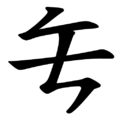Hanja facts for kids
| Hanja | |
 |
|
Quick facts for kids Korean name |
|
|---|---|
| Hangul |
한자/한문한자
|
| Hanja |
漢字/韓文漢字
|
| Revised Romanization | Hanja |
| McCune–Reischauer | Hancha |
Hanja is the Korean word for Chinese characters. It is about the Chinese characters that are borrowed from the Chinese language and used in the Korean language with Korean pronunciation. Hanja-mal or hanja-eo is about words which can be written with hanja. Hanmun (한문) is about the Chinese Classical writing, but hanja can sometimes be used to generally mean hanmun too. Hanja was never very greatly changed, so almost all of the Chinese characters in hanja are exactly the same as in traditional Chinese, except maybe the stroke order for a few words. Only a few hanja characters are unique to Korea.
In the 1440s, however, a Korean hangul alphabet relying on sound was made by a group of scholars, led by King Sejong the Great. It was not widely used at first. However, by the early 19th and 20th century it was more widely used than hanja, and it is now the official writing system of Korea.
But until then, everyone mostly read and wrote in hanja, so most of the older books in Korean literature are written in hanja. Scholars who learn Korean history learn hanja to read historical papers. Children in South Korea still learn hanja, for many South Korean words still have roots in hanja. In North Korea, however, hanja has been abolished along with many Chinese loanwords, and North Koreans only use hangul to write in Korean.
Related pages
Images for kids
-
A packet of Shin Ramyun, the Chinese character 辛, meaning "spicy", is prominently reflected
-
The Veritable Records of the Joseon Dynasty, an annual record of the Joseon Dynasty throughout its entire history, was written in Classical Chinese
-
This Korean War propaganda leaflet created by the US Army as part of Operation Moolah uses Hangul–Hanja mixed script.
See also
 In Spanish: Hanja para niños
In Spanish: Hanja para niños





